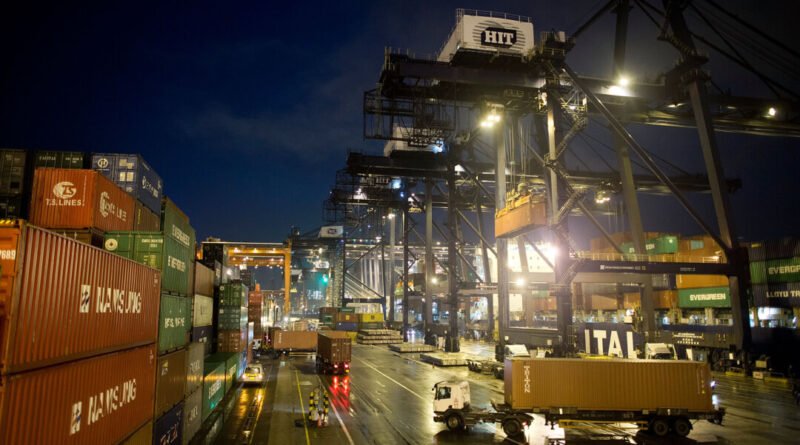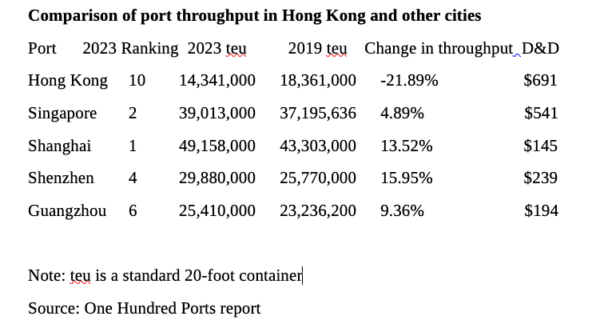For one major shipping alliance between Maersk and Hapag-Lloyd, Hong Kong is not long featuring as a direct port at all.
News Analysis
Hong Kong, once the world’s busiest container port, has seen its position decline over the past decade.
Several major shipping alliances have recently removed Hong Kong from some of their routes. Analysts attribute the decline to China-U.S. tensions, Beijing’s erosion of Hong Kong’s special status, and shipping companies’ pursuit of economic efficiencies.
Sea-Intelligence, a Danish consultancy, indicates that shipping companies are removing Hong Kong from their transshipment port lists.
Stephen Ng Tin-hoi, the chairman and the managing director of Hong Kong-based Wharf (Holdings) Limited, has also expressed concern about the situation at Hong Kong’s container terminals.
The shipping alliances Gemini Cooperation, THE Alliance, and Ocean Alliance, have all unveiled changes in their networks for 2024 and 2025, with Hong Kong deselected as a port along multiple routes,
reported Splash247.com, the Singapore-based media outlet covering international shipping news.
For Gemini, a new alliance between Maersk and Hapag-Lloyd, the southern Chinese city does not feature as a direct port at all.
“This does not bode well for the Port of Hong Kong, but should also be seen as a sign that an element of network consolidation is afoot, especially related to transhipment hubs,” stated a new weekly
report by Sea-Intelligence.
In Ocean Alliance’s network for this year, the number of times Hong Kong served as a direct port decreased from 11 to 6. The overview of the alliance’s trans-Pacific network for 2025 excludes Hong Kong from its services in the southwest and northwest Pacific.
According to Hong Kong’s Census and Statistics Department, as of 2022, trade and logistics was the leading industry in Hong Kong both in terms of economic contribution and employment, accounting for 22.5 percent of Hong Kong’s GDP—0.1 percentage point higher than that of the financial services sector (
pdf). The industry also employed 591,000 people, the largest in all sectors.
With the restructuring of shipping alliances’ networks, Hong Kong seems to be the first major victim, Sea Intelligence
said in a recent press release. With 91,400 companies engaged in import and export businesses in Hong Kong, employing 382,000 people, a shift in transshipment ports to other destinations is expected to have a serious impact on Hong Kong’s economy.
Data from the U.N. Conference on Trade and Development show that the throughput of Hong Kong’s shipping ports has been gradually declining compared to its neighboring Chinese ports, and that the connectivity of its ports is now significantly lower than Singapore.
Hong Kong’s shipping connectivity index in the first quarter of 2024 was 389.58, according to the U.N. data, much lower than China’s 1187.09 and Singapore’s 591.32. But a decade ago in the first quarter of 2014, Hong Kong’s shipping connectivity index stood at 505.23 next to Singapore’s 554.95, with China’s index showing less connectivity at 865.03.
Compared to 2019, the throughput of ports in Singapore, Shanghai, Shenzhen, and Guangzhou has all surpassed pre-pandemic levels. However, Hong Kong’s port throughput in 2023
dropped significantly by 21.89 percent compared to 2019. From Christmas 2023 to early this year, the Kwai Tsing Container Terminals were
reported to have zero container handling, according to local media. The situation for the rest of 2024 is expected to worsen.
Once the world’s top container port, Hong Kong fell to tenth place in 2023. It was surpassed by Singapore and Shanghai in 2005 and 2007, respectively.
While it may not be unnatural for Hong Kong to be overtaken, considering the different trading nations behind other ports—Singapore is benefiting from
oil transportation from Arab countries and Shanghai from China’s rapid economic growth after its WTO accession—the speed of Hong Kong’s shipping recession is surprising: Since 2004, the annualized growth rate of container throughput in Singapore has been 3.23 percent, 6.61 percent in Shanghai, and -2.22 percent in Hong Kong, despite continuous trade growth between the world’s two largest economies, China and the United States.
Hong Kong’s port was overtaken by Shenzhen in 2012, signaling regional competition. More symbolically, Guangzhou also surpassed Hong Kong in 2018. While Shenzhen’s throughput continues to grow, Hong Kong’s continues to decline. Mr. Wu pointed out that Shenzhen and Guangzhou’s Nansha Port have taken away a large amount of container volume from Hong Kong, and it is difficult to improve in the short term.
According to the Germany company Container xChange’s
report in June 2023, the average port fee in Hong Kong is $691, which is the most expensive in Asia, comparison to Singapore’s $541, Shanghai’s $145, Guangzhou’s $239, and Shenzhen’s $194.
US Tariffs on Chinese Goods
Despite Hong Kong’s advantages of being an independent customs territory, the U.S. government’s decision in August 2020 to label all imported goods from Hong Kong as “made in China” has made Hong Kong’s tariffs on U.S.-bound goods no different from those of China’s exports.
In the upcoming U.S. presidential election, Democratic candidate President Joe Biden’s policies target China’s semiconductor and technology sectors, while Republican candidate former President Donald Trump plans to impose tariffs of 60 percent or higher on Chinese imports. Regardless of who will be elected, the outlook for Hong Kong’s trade remains negative.
As neighboring Chinese cities gradually replace Hong Kong’s transshipment port status, Hong Kong faces a dilemma of insufficient internationalization and inadequate cost competitiveness. With its port throughput and
IPO rankings plummeting from first to tenth place globally, the city’s removal from transshipment port lists could further exacerbate the decline of the port.






